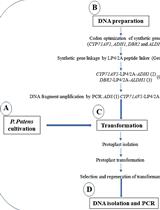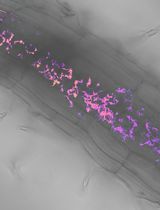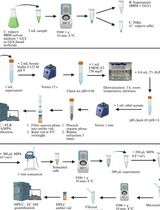- EN - English
- CN - 中文
Acetyl Bromide Soluble Lignin (ABSL) Assay for Total Lignin Quantification from Plant Biomass
采用乙酰溴可溶性木质素(ABSL)测定法定量植物生物量中的总木质素
发布: 2017年03月05日第7卷第5期 DOI: 10.21769/BioProtoc.2149 浏览次数: 17417
评审: Samik BhattacharyaRebecca Van AckerAnonymous reviewer(s)

相关实验方案

通过在体内直接组装多个DNA片段在青蒿中异源生产青蒿素
Nur Kusaira Khairul Ikram [...] Henrik Toft Simonsen
2023年07月20日 1840 阅读
Abstract
Lignin is the second most abundant biopolymer on Earth, providing plants with mechanical support in secondary cell walls and defense against abiotic and biotic stresses. However, lignin also acts as a barrier to biomass saccharification for biofuel generation (Carroll and Somerville, 2009; Zhao and Dixon, 2011; Wang et al., 2013). For these reasons, studying the properties of lignin is of great interest to researchers in agriculture and bioenergy fields. This protocol describes the acetyl bromide method of total lignin extraction and quantification, which is favored among other methods for its high recovery, consistency, and insensitivity to different tissue types (Johnson et al., 1961; Chang et al., 2008; Moreira-Vilar et al., 2014; Kapp et al., 2015). In brief, acetyl bromide digestion causes the formation of acetyl derivatives on free hydroxyl groups and bromide substitution of α-carbon hydroxyl groups on the lignin backbone to cause a complete solubilization of lignin, which can be quantified using known extinction coefficients and absorbance at 280 nm (Moreira-Vilar et al., 2014).
Keywords: Lignin (木质素)Background
The acetyl bromide method for quantification of lignin from plant biomass has been used to accurately measure total lignin content for decades (Johnson et al., 1961). Recently, this method has gained support as an optimal procedure for lignin quantification, as opposed to the alternative thioglycolic acid and Klason lignin methods (Moreira-Vilar et al., 2014). Comparison of these three methods has empirically shown that the acetyl bromide method consistently results in the highest recovery of lignin, and is insensitive to tissue type, extent of lignification, and lignin composition (Moreira-Vilar et al., 2014). In our previous work (Kapp et al., 2015), we adapted the scale of the acetyl bromide assay to facilitate a rapid, small-scale determination of lignin that uses a small amount of alcohol insoluble residue (AIR) derived from Brachypodium distachyon, based on a protocol described in the ‘Microscale Method for Cuvettes’ method detailed by Chang et al. (2008). The protocol described below can be performed with standard laboratory equipment and requires 5-9 days total after harvesting plant material, which can be derived from a variety of tissues or developmental stages.
Materials and Reagents
- Personal protective equipment (PPE; these should be worn at all times when dealing with concentrated acids and alkali. see Note 1)
- Safety glasses
- Lab coat
- Gloves
- Pipette tips
- Pipette set
- Ice bucket
- 2 ml Sarstedt tubes (SARSTEDT, catalog number: 72.694.007 )
- Plant material or cell wall preparation of choice
- Liquid nitrogen
- Acetone, ≥ 99.5% (EMD Millipore, catalog number: AX0120 )
- Lugol’s Iodine staining solution (Sigma-Aldrich, catalog number: 32922 )
- 1.5 N sodium hydroxide (NaOH, strong base), ≥ 97% (Fisher Scientific, catalog number: BP359-500 )
- 0.5 M hydroxylamine hydrochloride (strong reducing agent; store in Drierite container, make fresh in water), 98% (Sigma-Aldrich, catalog number: 255580 )
- Chloroform, ≥ 99.5% (Sigma-Aldrich, catalog number: C2432 )
- Methanol, ≥ 99.8% (Fisher Scientific, catalog number: A412P )
- Deionized water
- Ethanol, 100%, 200 proof (Decon Labs, catalog number: V1001 )
- Acetyl bromide (strong acid, violently reacts with water; dilute in acetic acid), 99% (Sigma-Aldrich, catalog number: 135968 )
- Glacial acetic acid, ≥ 99.7% (EMD Millipore, catalog number: AX0073 )
- DMSO (Dimethyl sulfoxide), ≥ 99.9% (Sigma-Aldrich, catalog number: 276855 )
- Chloroform-methanol mixture (see Recipes)
- 70% ethanol (see Recipes)
- 25% acetyl bromide (see Recipes)
- 90% DMSO (see Recipes)
Equipment
- 80 °C freezer
- Wiley Mini-Mill (Thomas Scientific, catalog number: 3383L10 )
- Cryogenic-compatible containers
- CryoMill ball mill along with all sizes of steel balls, grinding jars, safety valves, and Autofill (Retsch, catalog numbers: 20.749.0001 ; 02.480.0002 )
- Microcentrifuge capable of spinning at 10,000 x g (e.g., Eppendorf, catalog number: 5424 )
- Chemical hood
- Platform rocker (VWR, catalog number: 12620-906 )
- 10 ml glass graduated cylinder (Kimble Chase Life Science and Research Products, catalog number: 20024D-10 )
- NanoDrop 2000C spectrophotometer, or other UV-Vis (Thermo Fisher Scientific, Thermo ScientificTM, model: ND-2000C-PC )
- Quartz cuvette, 0.7 ml volume (Sigma-Aldrich, catalog number: Z600199 )
- Pipette
- Water bath or incubator capable of reaching 70 °C (e.g., VWR, catalog number: 89032-216 )
- Analytical balance (Mettler Toledo, Excellence Series )
- Vortex mixer (VWR, catalog number: 58816-123 )
- Tissue lyophilizer (4.5 Liter Freeze Dry Freeze Dryer) (Labconco, catalog number: 7750020 )
- Solid cap with PTFE Liner 15 mm, for 7 ml glass screw-cap vial (Sigma-Aldrich, catalog number: 27152 )
- Optional: Glass beads (Kimble Chase Life Science and Research Products, catalog number: 13500-4 )
- Optional: Reacti-Therm Heating and Stirring Module (Thermo Fisher Scientific, Thermo ScientificTM, catalog number: TS-18823 )
Procedure
文章信息
版权信息
© 2017 The Authors; exclusive licensee Bio-protocol LLC.
如何引用
Barnes, W. J. and Anderson, C. T. (2017). Acetyl Bromide Soluble Lignin (ABSL) Assay for Total Lignin Quantification from Plant Biomass. Bio-protocol 7(5): e2149. DOI: 10.21769/BioProtoc.2149.
分类
植物科学 > 植物生物化学 > 其它化合物
植物科学 > 植物新陈代谢 > 其它化合物
生物化学 > 其它化合物 > 木质素
您对这篇实验方法有问题吗?
在此处发布您的问题,我们将邀请本文作者来回答。同时,我们会将您的问题发布到Bio-protocol Exchange,以便寻求社区成员的帮助。
提问指南
+ 问题描述
写下详细的问题描述,包括所有有助于他人回答您问题的信息(例如实验过程、条件和相关图像等)。
Share
Bluesky
X
Copy link












